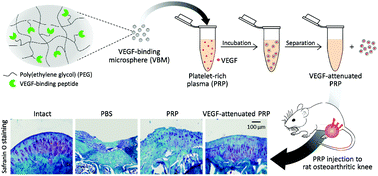VEGF-attenuated platelet-rich plasma improves therapeutic effect on cartilage repair
Abstract
Autologous platelet-rich plasma (PRP) has gained popularity as a less invasive treatment for various musculoskeletal tissue injuries and conditions due to its favorable safety profile, minimal manipulation and cost-effectiveness. Although PRP treatment has been clinically used for the treatment of osteoarthritis (OA) and damaged cartilage, evidence on therapeutic efficacy has been inconsistent, which calls for a methodology to achieve consistent and improved treatment outcomes. Given that PRP contains numerous proteins, we hypothesized that attenuation of a growth factor known to be detrimental to the healing tissue would enhance efficacy of PRP treatment. Considering that VEGF-mediated angiogenesis inhibits the repair of articular cartilage, we developed VEGF-attenuated PRP by sequestering VEGF in PRP using VEGF-binding microspheres. We demonstrated that VEGF attenuation in PRP did not inhibit the effect of PRP on chondrogenic differentiation of stem cells in vitro. In addition, healing of rat OA cartilage was significantly improved after treatment with VEGF-attenuated PRP when compared to the PRP treatment group or PBS control group. We expect that attenuation of unwanted biological activity using growth factor-binding microspheres could provide a new PRP customization method broadly applicable to various tissue repair processes.



 Please wait while we load your content...
Please wait while we load your content...